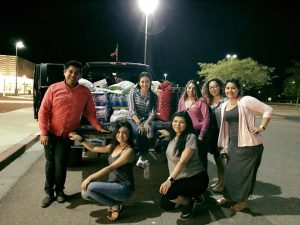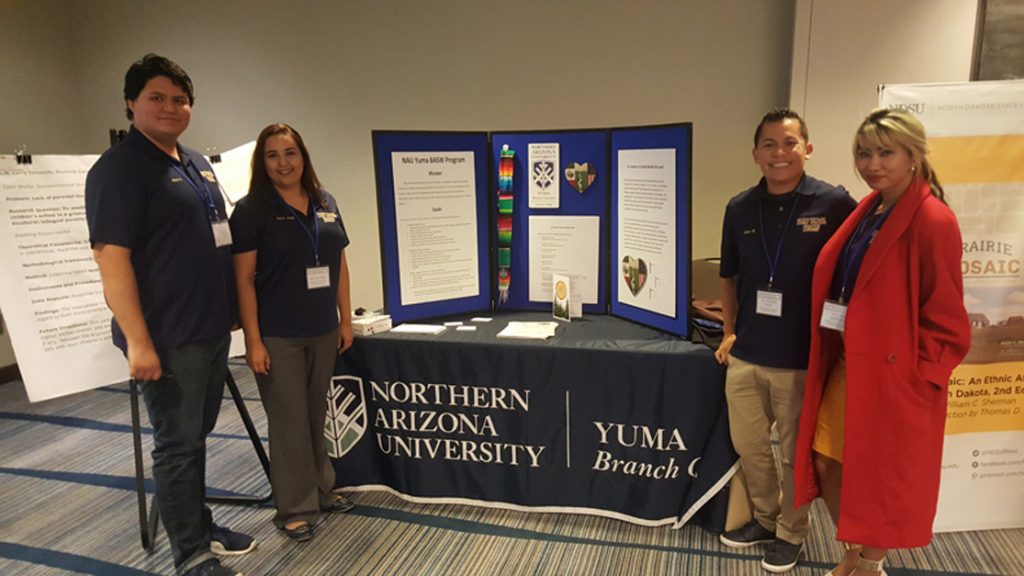By Heidi Toth
NAU Communications
Valeria Diaz was thinking about more than her future when she chose to enroll in the social work program at Northern Arizona University-Yuma. She was focused, rather heavily, on her present.
“I chose NAU-Yuma because at the time my family was going through some hardships, and I didn’t feel like it was the right moment for me to leave,” Diaz said. “I chose the social work program because I wanted to do something to help people with mental issues who do not get the help they need.”
The Yuma resident, who graduates in May, is one of the early enrollees in a social work that stands out from other programs. NAU-Yuma is the only bachelor’s of social work (BSW) program in the country to focus on U.S.-Mexico border issues, preparing students for work in an emotional, constantly changing, high-stress environment.
Program director Bill Pederson, who also is a principal lecturer, dismantled the curriculum a few years ago and rebuilt it according to the core competencies laid out by the Council for Social Work Education, the accrediting body. The program just completed the Benchmark 3 self study for accreditation and are anticipating being awarded full accreditation in February, which will be retroactive to August 2015.
The effort shows. The program has grown from six students in 2014, its first year, to 61 in fall 2016.
“The majority of our students are Hispanic, bilingual English and Spanish and first-generation college students,” he said. “Yet in spite of their challenges, we have had several Gold Axe winners and two Distinguished Seniors. At least a third of our graduates have gone on to obtain their master’s degree in social work.”
In one of the service learning classes, BSW students in Yuma count the homeless population in Yuma and Imperial counties. They then are required to develop a research proposal addressing a border issue or client system that is of particular interest to them. Many of these are actually put into action, Pederson said, and the students present their projects at the Western Social Science Association’s annual conference.
One project that made a significant contribution to the community was on pesticide poisoning among migrant farm workers. Students discovered that 33 percent of their sample population experienced three to four symptoms of pesticide poisoning from working in the local fields.
Another research project brought to light the disparity in health care and health insurance on both sides of the border and the adverse effects those disparities could have on both Mexicans and Americans working near the border.
“For example, since the Affordable Care Act, many border employers are only offering Mexican health insurance to their workers,” Pederson said. “This presents tremendous difficulties for the English-only speaking employees. In addition, if a person should develop a catastrophic illness, such as cancer, the Mexican lifetime insurance benefit is more often than not depleted before the biopsy is read. Then, as the people try to obtain American health care, ICE policy prevents them from bringing the tissue across the border, leaving them without a diagnosis, treatment or insurance.”
In all, BSW student-driven research and volunteer work in Yuma and Imperial counties is valued at more than $1 million, Pederson said. Much of that work is built into the curriculum, which includes:
- BSAW 321 requires that students visit housebound elderly people, many of whom only speak Spanish.
- BASW 315 is designed to help students learn cultural competency among all types of cultures and groups.
- BASW 452 focuses on high-risk border populations, with students learning how to provide services to local law enforcement, U.S. Border Patrol, military personnel and Spanish-speaking migrant farm workers.
- BASW 453 requires students to provide community forums in Yuma and Imperial counties on a relevant border issue. Two years ago, students in this class had forums to discuss human trafficking, which the campus’ Social Work Student Association then turned into a two-year Human Trafficking Awareness Project. In April, the association won the Rodney Mather Service Award for that project.
- BASW 420 requires students analyze a state policy that is relevant to the border. At the end of the course they present oral testimony and a paper on that policy and its likely impact on border populations.
For Diaz, although she anticipates all the classes will help her as a social worker, the classes discussing mental health and public policy have been most useful. Both gave her the tools she’ll need to go into the mental health field, she said.
“It is a tough program, and it teaches you that you need to go out into your community and be aware of what is going on before you can even think about helping anyone,” she said. “Since starting the program, I have become a lot more aware of the problems in my community, and I don’t think I would have looked at them so deeply without being in this program.”
NAU Yuma social work students also complete 540 hours of supervised field work as a practicum; all of the placements are in agencies

along the border and serve a predominantly Hispanic population. As part of their senior seminar, students develop a case scenario from that practicum and apply the core competencies they’ve learned in the classroom to that case. Often, Pederson said, students select cases that present some sort of challenge from living on the border.
Living and learning
The first day of classes at NAU-Yuma, much of the city of Houston remained underwater as Hurricane Harvey battered Texas with rain.
Between classes, seniors in the Social Work Student Association talked with the younger students about the importance of community engagement and service. In two days, the group gathered a truckload of clothing, water, diapers and household supplies for the victims in Texas.
“This donation brings us satisfaction, knowing we are helping strangers miles away in their time of need,” Diaz said.



